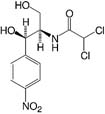Chloramphenicolresearch grade, Ph. Eur.
- Pack Sizes
- Certificates of Analysis (Lot.-no. - release date)
- PDF Documents
- Additional Information
- Related Products
- Product Links
C11H12Cl2N2O5 • Mr 323.1 • CAS [56-75-7]

Chloramphenicol is an antibiotic, isolated from strains of Streptomyces venezuelae. It blocks bacterial protein synthesis by inhibiting the peptidyl transferase activity of the 50S ribosomal subunit. The antibiotic has a broad application range against gram positive and gram negative bacteria.
Chloramphenicol is used for bacterial selection and plasmid amplification in molecular biology applications and as a selection agent for transformed cells containing chloramphenicol reistance genes.
A stock solution opf 50 mg/ml in ethanol yield a clear, very faint yellow solution. For selection of chloramphenicol-resistant Escherichia coli a concentration of 30 - 50 µg/ml are typically used.
|
Assay (UV)
|
98.0 - 102.0 %
|
References:
- Wal, J. et al. (1978) J. Chromatogr. 145, 502-6
- Danzer, L.A. (1983) Clin. Chem. 29, 856-8
- Rüssel, H. (1978) Chromatographia 11, 341-3
- Long, K.S. & Porse, B.T. (2003) Nucl. Acids Res. 31,7208-15
- Izard, T. (2001) Protein Sci. 10, 1508-13
- Schwarz, S. et al. (2004) FEMS Microbiol. Rev. 28, 519-42
- Zhu, H. et al. (2011) Int. J. Agric. Biol. 13, 677-82
- Munshi, T. et al. (2013) PLOS ONE 8(3):e60143
 |
| DANGER |
| Hazard Statements | H350 - H361 |
| Precautions | P201 - P202 - P280 |
| Reaction | P308 +P313 |
| Storage | P405 |
Carc. 1B, Repr. 2 • EINECS: 200-287-4 • WGK: 3 • HS: 29414000
Storage Temperature: +15 °C to +30 °C








